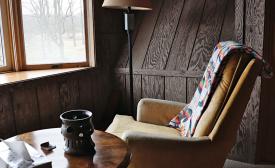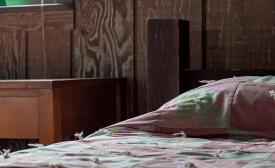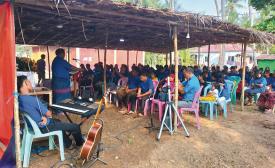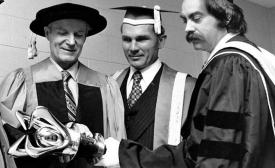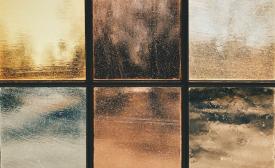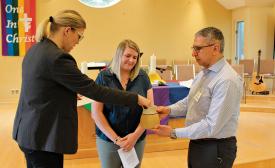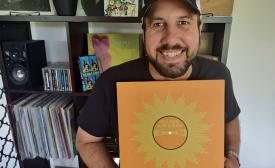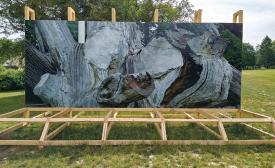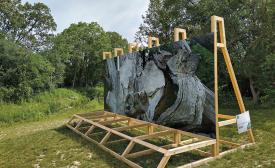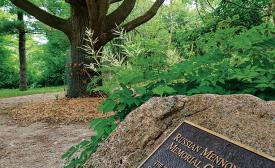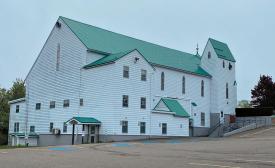Volume 27, Number 13
The poofy blue MCC couch
When I worked at the Mennonite Central Committee (MCC) office in Winnipeg 20 years ago, I took pride in showing up early. Occasionally I even arrived before Norm, the custodian, who turned the lights on at 7 a.m.
Sometimes, I was also the last to leave.
I was doing advocacy with a Cree community and there was no shortage of passion or work.
Rest and Restlessness
We asked the Canadian Mennonite community to reflect on rest and restlessness.
Readers write: June 30, 2023 issue
A plastic chair partnership
I was recently tasked with writing a “giving catalogue” that will highlight various activities of Mennonite Church Canada International Witness.
Peter J. Dyck
Peter J. Dyck was recognized with an honorary doctorate from the University of Waterloo on Oct. 18, 1974. Dyck was born in 1914 and immigrated with his family to a farm near Laird, Saskatchewan, in 1927. During World War II, he and his wife, Elfrieda were part of the MCC work in Europe helping refugees emigrate. Dyck studied and served as a pastor in the U.S.
Unity and uniformity
As a preteen more than 50 years ago, I remember asking my mom about the difference between Baptists and Mennonites, given that we were members of a Fellowship Baptist church while all our relatives were Mennonite Brethren. My mom stumbled to find an answer.
Worship through visual art
If you have flipped through Voices Together, you have likely found that visually it looks like many other worship and song collections, with one noticeable difference: the inclusion of visual art. Unlike previous collections, the new hymnal contains 12 works of art which are interspersed throughout the collection, depicting acts of worship and aspects of the Christian story.
Let’s talk about spiritual experiences
In my April column, I invited Canadian Mennonite readers to email me their experiences, thoughts and questions about the Holy Spirit. I’m humbled and grateful to the many people who took the time to formulate responses and send them to me. Thank you for trusting me with your stories. I have been encouraged.
Four models of multiracial church
In his 2003 book, One Body, One Spirit: Principles of Successful Multiracial Churches, George Yancey shares the results of a major study funded by the Lily Endowment and conducted by Michael Emerson, Karen Chai and Yancey.
The researchers discuss four distinctive types of multiracial churches. Below, I analyze these types from a Mennonite perspective.
A voice for peace
Pastor Reuben Tut and his church, Edmonton South Sudanese Church, celebrated God’s calling of Tut at his ordination on May 13. God’s call has pursued Tut through doubts, civil wars and across two continents.
Cheryl Braun ordained in Manitoba
The Glenlea Mennonite Church family was thrilled to ordain Cheryl Braun on June 11, in the presence of not only the local congregation but also many of Cheryl’s friends and family who came to show their support.
Carrie Lehn ordained at Ottawa Mennonite
Carrie Lehn, associate pastor of Ottawa Mennonite Church, was ordained in the Sunday morning service on June 18. For Carrie, it was a sacred and special moment, and a milestone affirmed and celebrated by Ottawa Mennonite Church (OMC), where she has worked for the past decade.
From postman to pastor
After eight years of study, Ian Funk was thrilled to finally receive his Master of Divinity degree in May, albeit in absentia.
Funk, pastor of Langley Mennonite Fellowship, completed his MDiv courses from Anabaptist Mennonite Biblical Seminary (AMBS), located in Elkhart, Indiana, through the seminary’s distance education program, which combines online and hybrid classes.
Something to tock about

An exhibit now on display at Gallery in the Park in Altona, Manitoba features more than 20 Mennonite clocks. (Photos courtesy of the Kroeger Clocks Heritage Foundation)
Clockmaking was a skilled trade among certain Mennonites for more than two centuries, and a striking exhibit at Gallery in the Park in Altona, Manitoba, displays the art and heritage of the Kroeger clocks, as they are commonly known.
Pastor adds music producer to his resumé
Pastor, professor and rock music impresario—David Cramer’s CV is diverse.
Khortitsa oak art installation
I sat in the shade of an oak tree on the first day of summer outside Conrad Grebel University College in Waterloo and listened to a recording of the sounds of a spring morning at the site of that oak tree’s parent in Ukraine.
Ojibwe tour of Mennonite reserve
Standing at an intersection of mile roads on the more-or-less open prairie near Neubergthal, Manitoba, David Scott explained how members of the Ojibwe Grass Dance Society once called that area home.
“This landscape has changed so much,” he said, noting that he came to the area in his youth for ceremonies.
Cape Breton church hosts disaster responders
“Everyone is excited—there’s a buzz in the air.”
That’s what Dana Feltmate, the minister at Sydney River Protestant United Church in Sydney, Nova Scotia, said about hosting the Mennonite Disaster Service (MDS) response to Hurricane Fiona in Cape Breton.
Train trip to mark 100th anniversary of Mennonites coming to Canada from Soviet Union
One hundred years ago, the first of 21,000 Mennonites who left the former Soviet Union boarded a train in Quebec City for new lives across Canada. On July 6, some of their descendants, along with others, will replicate that journey. Over 120 people have signed up for all or parts of, “Memories of Migration: Russlaender Tour 100,” a three-stage train trip from Quebec City to Abbotsford, B.C.
Tactile land acknowledgment
Land acknowledgments are usually spoken, but Angela Hildebrand was curious how they could be expressed in other mediums. “Being a very visual person, I resonate a lot with things I can see, touch,” she said. “So I began to think about, what would that look like for me, for our fellowship?”


